Artificial intelligence in the workplace: What should you be aware of?

Director of Content

Tags
Share
It’s no longer a forward-looking statement to say that artificial intelligence (AI) is transforming the modern workplace.
At this point, AI has landed in all of our offices in some shape or form, whether we’re aware of it or not, from marketing and sales to customer service.
I’ve been very lucky in that I work at an AI company, and I have AI tools that I’m using every day. More importantly, I’ve seen the benefits of AI firsthand. As a writer, editor, and content marketing leader, what used to take my team and me days or weeks to do now takes me literally a few hours.
And beyond that, I know from talking to our customer support and sales leaders that AI is empowering their reps and agents to close more deals and support customers better too.
I’ll walk you through all of those AI use cases for work below, and what to be aware of if you’re interested in using AI in your everyday work.
What is artificial intelligence and how does it impact the modern workplace?
Artificial intelligence is the name given to the vast field of machine-simulated human intelligence. There is an endless variety of how AI can be applied and what it can do, from natural language processing and speech recognition to even fraud detection and medical diagnosis.
How does AI impact the workplace?
AI is already having a major impact on the workplace in a number of ways. One of the most popular or most common impacts that people are already talking about is how it can automate a lot of different tasks for employees.
I’ll get into a few specific examples in the next section, but automation is a big one. Another way that AI is impacting workplaces is in how we gather and organise data. Almost every team has to monitor metrics specific to their department.
Customer support teams have specific contact centre KPIs, marketing teams have their campaign performance numbers—and AI has the ability to not only gather large amounts of data, but also sort through all of that information much more quickly than humans can. This is especially true when you’re looking at qualitative data, like customer feedback and call recordings, as opposed to just raw numbers.
Examples of artificial intelligence in the workplace
Now, let’s look at how many of us are already using AI at work.
Auto-completing emails
Fun fact: You know that super-helpful auto-complete feature in Gmail that kind of predicts what your next word will be, and can even remind you to attach a file if you forgot? That’s AI at work:
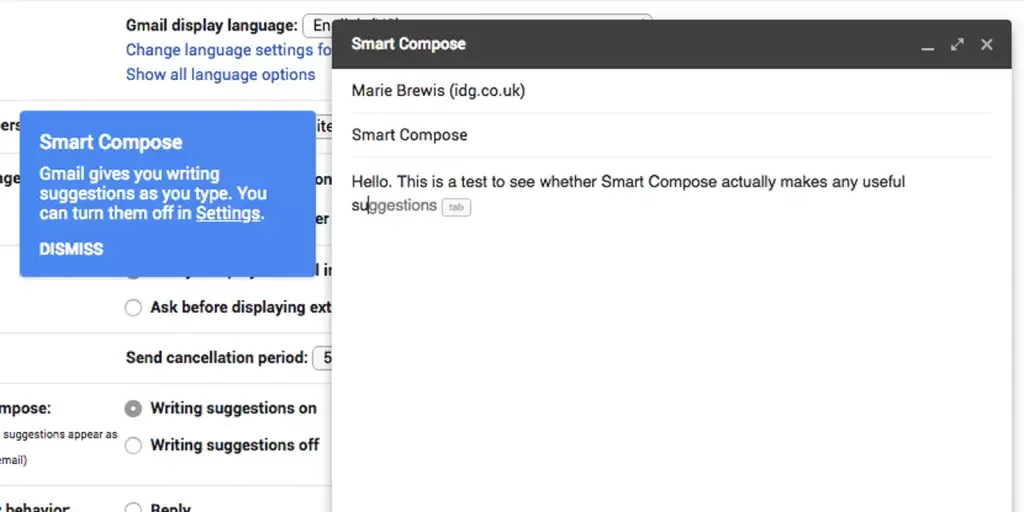
Conversational AI on websites and digital channels
Five years ago, nobody liked chatbots, and I mean nobody. I hated them. You’d try to ask a chatbot something, and it would force-suggest three or four answers that had nothing to do with your question. Which made you realise, “Oh, whoever designed this chatbot flow didn’t think to pre-set this question because I guess I’m the first person to have this issue.”
Waste of time (that you could’ve just used to call and talk to an agent directly).
Today, that’s changed a lot. Instead of chatbots, we’ve got the next evolution: conversational AI—which is kind of like a super smart chatbot that can answer a much larger variety of questions.
For example, I moved recently, and I had to move my internet service to my new place. I tried calling, and there was a long wait time (not a surprise with this provider), so I thought I’d try the chatbot on their website while I was on hold. I had nothing to lose at this point.
To my (very pleasant) surprise, the conversational AI understood my (not-very-well-phrased) question and got me the answer I needed pretty quickly:

If you’ve ever tried booking a trip or hotel, you’ve probably come across conversational AI on WhatsApp or other messaging channels like Apple Business Chat too. And if it’s anything like this experience, you probably had a much better time than waiting on hold or talking on the phone with someone.
It’s not that hard to set up these flows either—you don’t need to know how to code, and it could just take a few minutes. In fact, here’s how it looks in Dialpad Ai Contact Centre. It’s just a drag-and-drop builder, and anyone could do it:
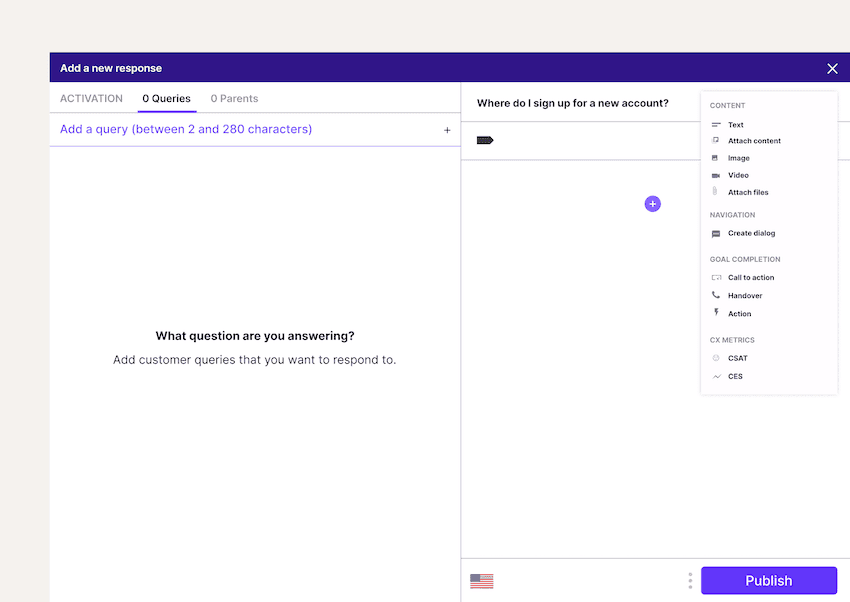
Sales objection handling
AI is helpful for sales teams too. If your sales team makes a lot of cold outbound calls or just has a lot of conversations with prospects in general, they probably come across their share of objections from those prospects.
They might ask about pricing, bring up competitors, and grill your reps about the specifics of your product features and services. AI can help them talk through these tough conversations. For example, Dialpad’s real-time Ai Agent Assist automatically searches all your connected knowledge sources (even unstructured ones like PDFs and past customer conversations) to pull relevant information right onto the rep’s screen:

This is incredibly helpful whether you’re onboarding new hires who aren’t as familiar with your products, or just want to maintain that high level of “knowledge consistency” across your team. And all with minimal manual work too.
Customer service topic tracking
Similarly, customer service AI can do this too, but in a support context. So instead of objection handling and competitor talk tracks, Dialpad’s Ai Agent Assist can pull troubleshooting tips and answers to FAQs for customer support agents.
But beyond helping agents live during customer calls, AI can also help supervisors with monitoring common questions and issues that come up, so they can improve their contact centre training materials and the overall customer experience.
For example, with Dialpad Ai’s speech recognition ability, our supervisors can create “Custom Moments” to track specific keywords and topics. Want to see how often customers are asking for refunds? You can create a Custom Moment to track every time “money back,” “refund,” and/or “cancel” is said by a customer on a call:
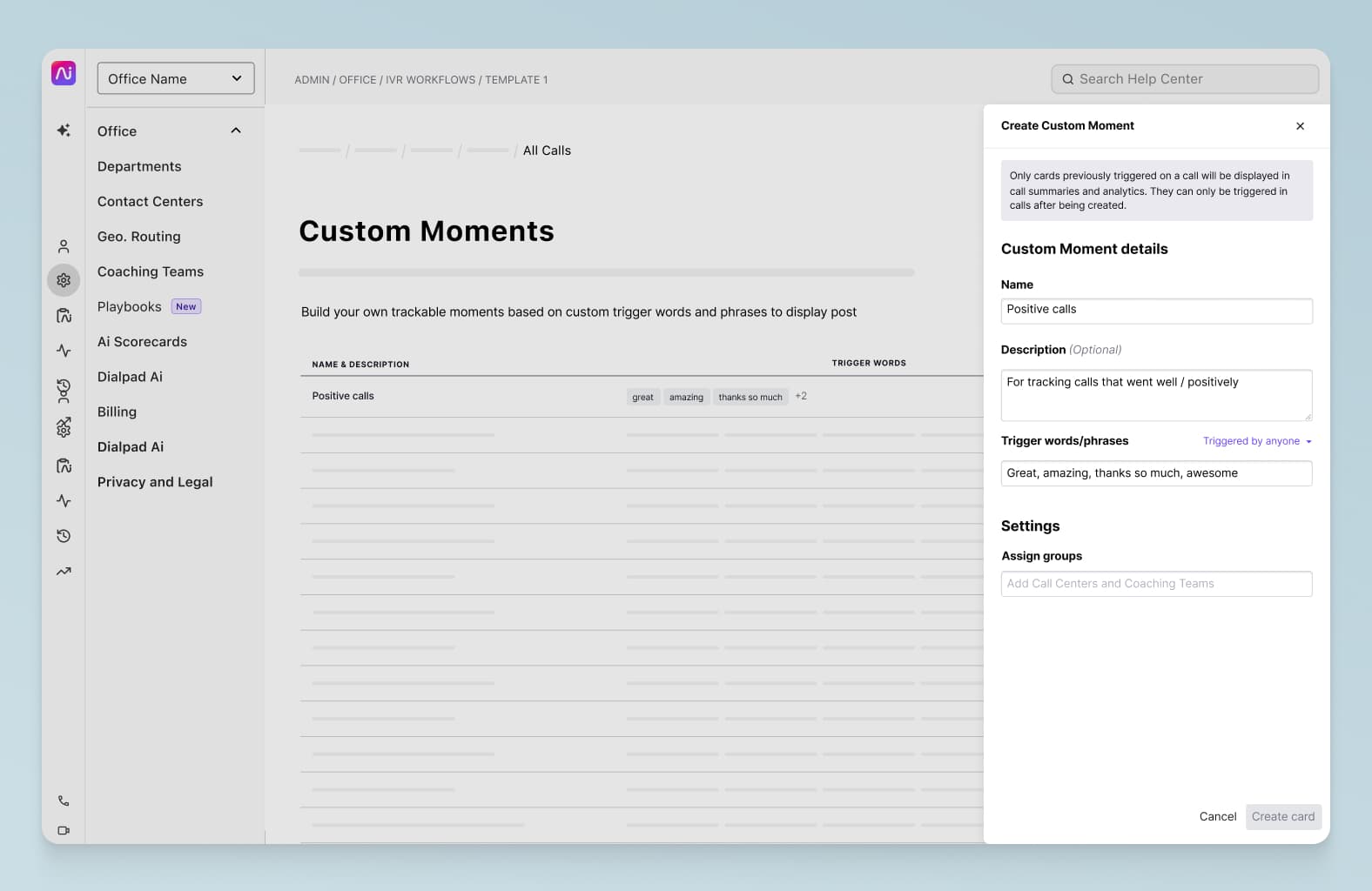
Faster QA
In customer support, managers and supervisors typically also have to do quality assurance (QA) on their agents’ performance. Instead of grading each agent manually one by one, AI can help by automating parts of this grading process.
Did the agent greet the customer? Did they try an upsell or cross-sell at the end of the call? AI can already transcribe calls and detect keywords, and this is just another example of what conversational intelligence can do when it comes to contact centre optimisation.
Gauging customer satisfaction
If you’re running a contact centre and overseeing a team of tens (or even hundreds) of agents, things can get overwhelming. With so many calls happening simultaneously, how can a manager quickly see if an agent needs help or if a call with a customer is going badly?
AI can do live sentiment analysis, which means it can instantly flag calls with negative sentiment to the supervisor. That’s what Dialpad Ai can do—and if you do see a call with negative sentiment, you can just open up the live transcript to get more context before deciding if you need to listen in or barge the call:
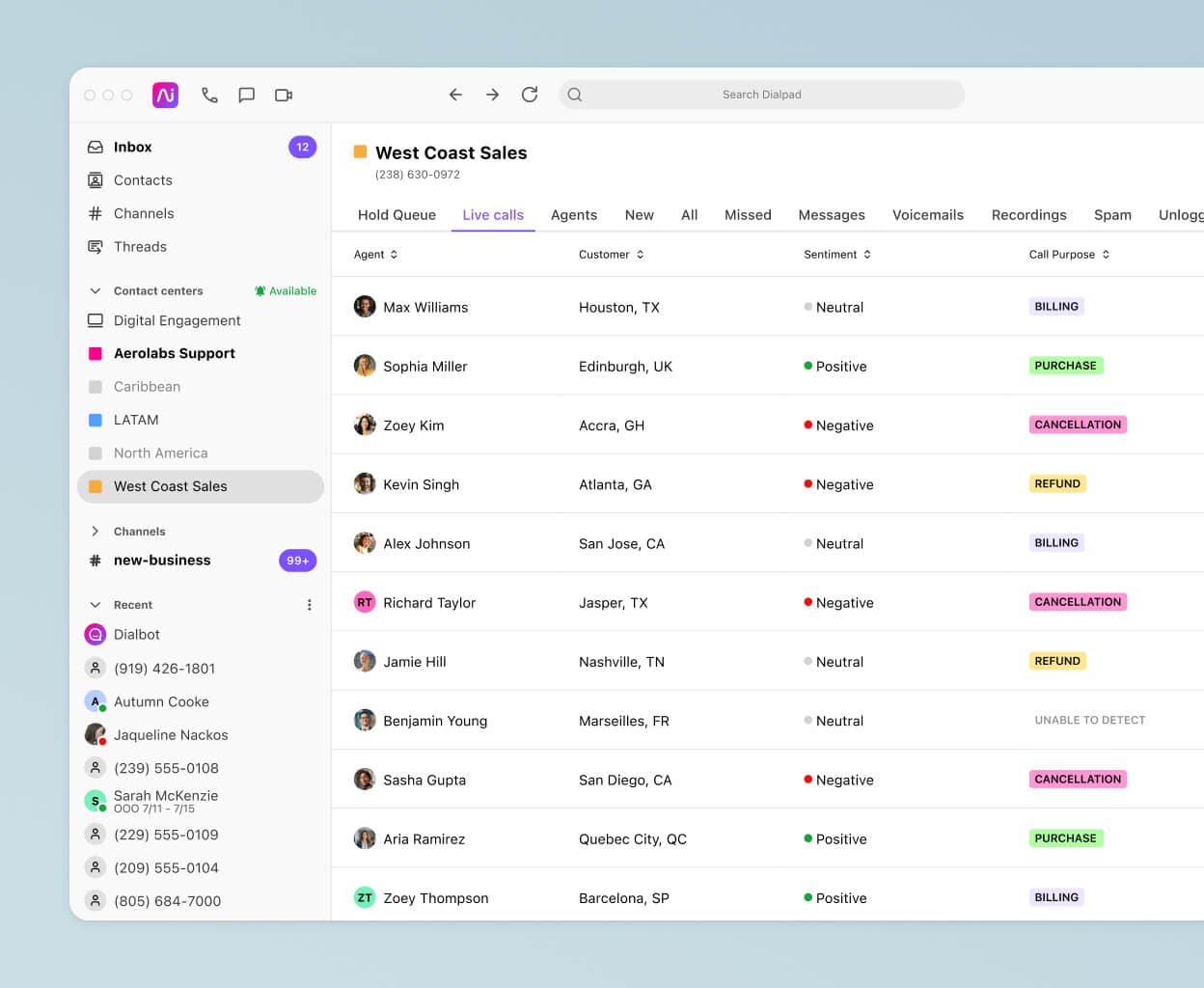
On top of that, Dialpad Ai can also infer CSAT scores—without you needing to run surveys. It's commonly known that one of the biggest challenges with doing customer satisfaction surveys is that not a lot of people actually fill out those surveys.
And usually only the angriest—and happiest—customers actually bother responding, which means your CSAT feedback is likely to be very skewed and not representative of how your customers feel overall.
Dialpad's industry-first Ai CSAT feature is designed to solve exactly that, by inferring CSAT scores for 100% of your customer calls thanks to its hyper-accurate transcription feature. The result: a much more representative sample size for CSAT scores, and a more accurate understanding of how satisfied your customers really are:
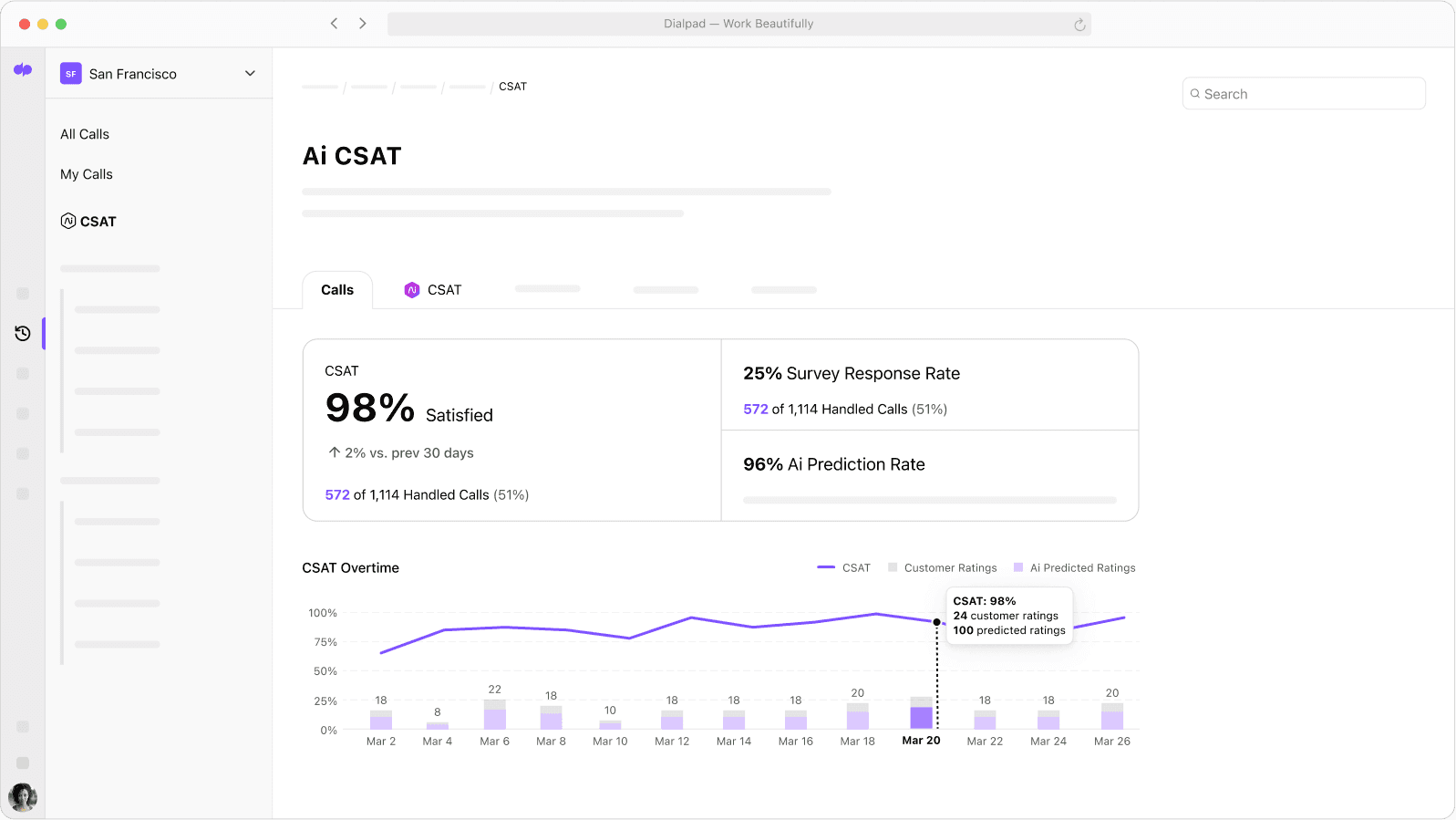
Generating marketing content
Since I’m a marketer, you know I had to include a big marketing use case for AI. Today, most B2B and B2C companies have some kind of content strategy that involves their blogs and websites.
In my current and past lives, the companies I’ve worked for all required some mix of blog posts, ads, web pages, eBooks, and so on to be written. And as a writer, writing a 2000-word article from scratch can take anywhere from a day or two (if you’re fast) to a week or more.
With an AI writing tool, I can produce a pretty solid piece of content in about two or three hours. Granted, AI is nowhere near perfect right now—it can’t cite sources, it doesn’t interview subject matter experts, and I still have to edit every draft that it generates pretty extensively (which is where the two or three hours come from). If I’m honest, I don’t think AI will be able to generate marketing copy that requires zero oversight anytime soon.
But.
AI can get me to an okay first draft that I can start editing in seconds instead of hours. And if you work with freelancers who typically have a turnaround time of days or weeks, this time difference matters, especially if you’re in a competitive industry like I’m in where you want to produce a high volume of content quickly.
The benefits of artificial intelligence in the workplace
From the AI use case examples we just looked at, you can probably already tell what the benefits of AI are for businesses: time savings, cost savings, increased productivity, and less “busywork.”
AI is not perfect by any means and it’s nowhere near its “final form” yet, but even now, it’s already doing quite a bit! All of the customer support and sales use cases I mentioned above are happening in real life with Dialpad Ai today—and there’s more coming down the pipe soon that I can’t talk about just yet, but are very exciting.
That being said, there are both pros and cons of AI, and general considerations to keep in mind if you’re interested in using AI in your workplace:
Know the limits of AI
Even though AI can do a lot even now, it still needs some degree of oversight. For example, you probably don’t want to have ChatGPT on your insurance company’s website just giving answers to customer questions about life insurance policies and claims without giving some serious thought to how you design those flows, where the AI pulls the answers from, and so on.
Know the differences between AI tools
This is related to the first note, and it’s a big consideration. Every company claims to have AI or ChatGPT now. We know this, because all of our competitors are doing this too.
But large language models like ChatGPT are trained on pretty broad data sets. Do you know what the AI tool you’re using is trained on? Because if the answer is “everything we could find on the internet, including Reddit and YouTube,” then the answers that this generative AI will give you will reflect those data sets it “learned” from.
I had to learn about this because I work at an AI company, and one thing that was interesting to discover is that Dialpad is trained on business conversational data only—because Dialpad is an AI platform designed for work.
This is where you have to decide: does it make sense for the AI tool you’re using for work to be trained on every single piece of data that’s ever existed on the internet?
Know what you want to use AI for
The applications of AI in the workplace are infinite. I’m not really one for hyperbole or absolutes, but I feel comfortable saying that now.
Having had a front seat in the AI world for a couple years now, I could list off the eight or nine use cases earlier off the top of my head, but I know there’s way more that I haven’t even imagined.
Just the other day, I found out that AI can suggest medical diagnoses. That it can help lawyers with document discovery and can even poke holes in their opponent’s cases. If you dig deep into different industries, I’m sure AI can do a lot more, specifically for each of those industries. And we’re what, just a few years in?
To really get the most benefit out of AI for your work, I’d really suggest first thinking about where your pain points are, where time is being wasted, or where you feel like you’re not being super productive. From here, you can start thinking, “Okay, is there an AI tool that can help with this?” It’s going to make things less overwhelming and you’ll at least have a starting point instead of just trawling the thousands of AI tools out there one by one.
Are you using AI at work yet?
If you aren’t already, my guess is it’ll happen soon. It’s just a matter of whether you’ll be the one to be curious enough to look into it, or if your boss tells you tomorrow that you’ll be using X new AI tool.
Despite what you may think from this blog, I am wary about AI. I do think there are many ethical considerations that decent human beings should think about when it comes to how AI is used and how it is designed.
But I’m also curious.
I don’t think anyone is going to be able to close Pandora’s Box at this point, and the better we can understand both its benefits and shortcomings—the way we had to learn how to understand and work with the internet when it first came into existence—is crucial.
Curious about AI in the workplace?
See how companies are using Dialpad Ai to provide better customer service, close more deals, and work more productively! Book a chat with our team, or take a self-guided interactive tour of the app on your own!








